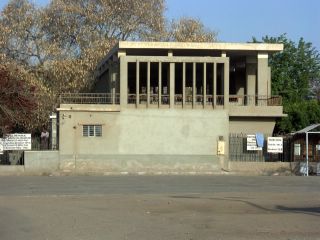Memphis
We spent about an hour in Saqqara, until we were told to leave when it closed. Later we rushed to Memphis.
Memphis was the ancient capital of the Old Kingdom of Egypt from its foundation until around 1300 BC. The ruins are 19 km (12 mi.) south of Cairo on the West Bank of the Nile. The city was founded around 3100 BC by Menes of Tanis, who united the two kingdoms of Egypt. Memphis reached a peak of prestige under the 6th Dynasty as a centre of the cult of Ptah. It declined briefly after the 18th Dynasty with the rise of Thebes and was revived under the Persian satraps before falling into firm second place following the foundation of Alexandria. Under the Roman Empire, Alexandria remained the most important city. It remained the second city of Egypt until the establishment of al Fustat (or Fostat) in 641. Memphis was then largely abandoned and became a source of stone for the surrounding settlements. It was still an imposing set of ruins in the 12th century but soon became little more than an expanse of low ruins and scattered stone. The remains of the temple of Ptah and of Apis have been uncovered at the site as well as a few statues, including two four metre ones in alabaster of Ramesses II.
As you can guess, it's closed. But nonetheless, I have stepped on the land of Memphis, the oldest city of Egypt civilization, and also the largest city in the world from its foundation until around 2250 BC, with population of over 30,000.

Memphis Museum, which built around a fallen colossal limestone statue of Ramses II
Memphis was the ancient capital of the Old Kingdom of Egypt from its foundation until around 1300 BC. The ruins are 19 km (12 mi.) south of Cairo on the West Bank of the Nile. The city was founded around 3100 BC by Menes of Tanis, who united the two kingdoms of Egypt. Memphis reached a peak of prestige under the 6th Dynasty as a centre of the cult of Ptah. It declined briefly after the 18th Dynasty with the rise of Thebes and was revived under the Persian satraps before falling into firm second place following the foundation of Alexandria. Under the Roman Empire, Alexandria remained the most important city. It remained the second city of Egypt until the establishment of al Fustat (or Fostat) in 641. Memphis was then largely abandoned and became a source of stone for the surrounding settlements. It was still an imposing set of ruins in the 12th century but soon became little more than an expanse of low ruins and scattered stone. The remains of the temple of Ptah and of Apis have been uncovered at the site as well as a few statues, including two four metre ones in alabaster of Ramesses II.
As you can guess, it's closed. But nonetheless, I have stepped on the land of Memphis, the oldest city of Egypt civilization, and also the largest city in the world from its foundation until around 2250 BC, with population of over 30,000.

Memphis Museum, which built around a fallen colossal limestone statue of Ramses II





0 Comments:
Post a Comment
<< Home